
Previous medical history
Nicki lived on a farm in Austria. This operation keeps Tinker stallions and mares for breeding purposes and at the same time for mare's milk production. In order to produce mare's milk, it is necessary that the mares that are milked bare a new foal every year.
The previous owner of the farm had already handed over the operation to his son, but was still interested in the horses. Since he had learned about the work of a colleague on another horse with hoof canker, he asked her to look at Nicki and assess her hooves.
Nicki was one of the mares that were used for the mare's milk production, and therefore had to bare a foal every year. On the day when the Hoof orthopedic met Nicki she had a foal at foot, was therefore currently in the milk production and already baring again.
Each of Nicki's four hooves was afflicted with hoof canker. The hoof orthopedic told the former owner of the mare, that in order to heal the desolate and painful condition of the hoofs, it would first of all be necessary to have the hooves professionally treated on a regular basis and at frequent intervals. In addition the hoofs would need daily and time-consuming care. She also pointed out that the bedding in Nicki’s box stall had to be kept significantly better and the mare would need a lot of exercise on a clean paddock.
Unfortunately, having already handed over the farm to the son, the former owner no longer had any influence on the stable and the horses. Furthermore, for reasons of age, he was no longer able to take care of Nicki alone. Therefore, the hoof orthopedic had a telephone conversation with the son and new owner of the operation. But unfortunately, she could not achieve an improvement for Nicki's general situation, nor could she find agreement in order to address the hoof ailment. For the moment, she had to leave the farm without having achieved anything.
The entire situation for all horses on this farm; the generally poor housing conditions, the ammoniac filled air in the stable, the too small and scarcely bedded boxes (especially for mares with a foal at foot), the breed heifers put together in confined space without turnout, the poorly cleaned open stable area with beggarly turnout for the stallions, in addition to that at least one other horse with hoof canker, - all that and the prospect that neither improvement, let alone being able to achieve a remedy, left the orthopaedic very depressed.
After she had led some talks with other stable operators and horse owners, who knew of the mare milk operation and the existing problems there, she decided to file a report to the competent authority in Austria. Shortly thereafter, the operation was inspected by the district veterinarian. The operator received extensive requirements for its stable facility and the requirement to seek treatment for Nicki’s hoof canker.
However, the facility operator and also owner of Nicki obviously still had no interest in a hoof treatment for Nicki. Since the mare was in foal, he could not find a butcher for slaughter. Nevertheless, the requirements of the district veterinarian made it necessary to find a solution. As a result Nicki was able to be "redeemed" from the operation for a purchase price of 300 euros.
Before the 1st treatment on March 13th, 2012



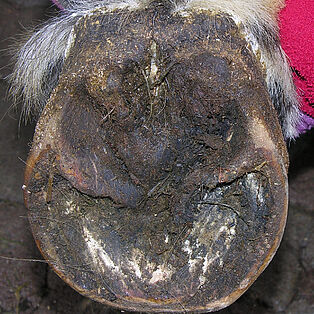
After the 1st treatment on March 13th, 2012


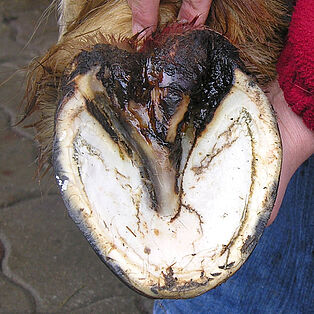


In addition to trimming the hoof, the initial appointment included a leech therapy. Two leeches were applied per hoof, which "began their work" at the bulb in the middle sulcus (frog-groove).
Leeches are obviously in a position to improve the poor circulation situation that often exists with hoof canker (with many small blood clots in the blood vessels). In addition to this are the anti-inflammatory, germ-reducing and activating healing effects of the leech therapy.

The new owners washed Nicki’s hooves daily and rinsed them with Rivanol. The medicine which was applied into the deep pockets of the hooves, is normally used to dry the udder of cattle (so called drying agents). Nicki had a large box stall with dry shavings and was turned out daily on an especially for her provided clean paddock with closed sward.
A second leech treatment was waived, since the progress of the treatment continued to be very good. The effect of leech therapy is often long lasting. One should first think about further treatment when the effect wears off. The motto: “less is often more” applies here.
Before the 2nd treatment day on March 27th, 2012




After the 2nd treatment day on March 27th, 2012


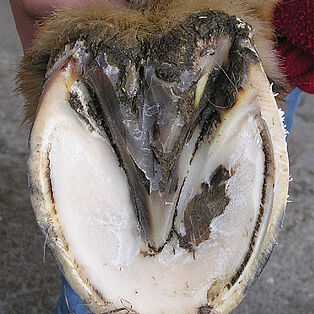

For the further treatment it was very important to transform the shape of the hoof, especially the heels. Nicki had - as many horses with hoof canker do – a hoof that promotes the emergence of this disease. The heels are at an oblique angle towards the outside. Allowing the heels to become even more slanted will result that under load the hoof, although expanded in the lower area, will narrow at the top so that the bulb of the heel becomes contracted.
This situation leads to a contusion of the coria, particularly in the central frog groove. The resulting over stimulated, inflamed corium contributes to the origin of hoof canker and prevents its cure. Therefore, the goal of the hoof treatment needs to be a restoration of the contracted bulb. If no such change in the hoof is achieved, the hoof canker will, despite all medication, be resistant to treatment or will, after a short quiet phase, in most cases break out again.
After the 3rd treatment day on April 19th, 2012
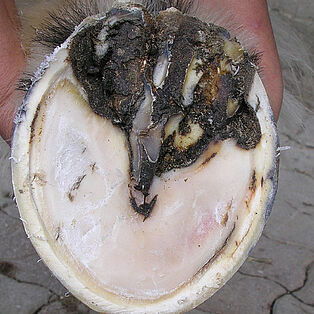
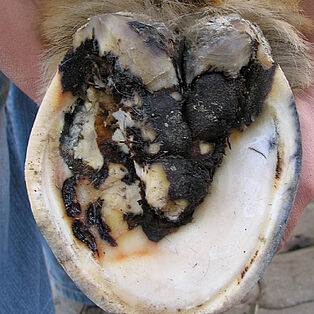

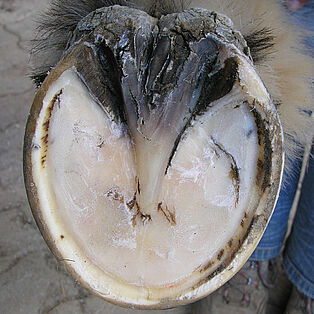
After the 4th treatment day on May 8th, 2012




After the 5th treatment day on May 23th, 2012




After the 6th treatment day on June 7th, 2012

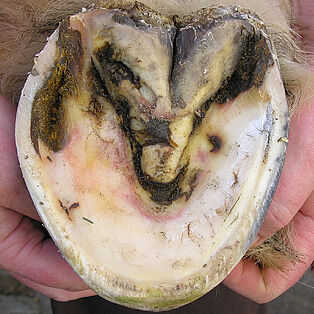


After the 7th treatment day on June 29th, 2012


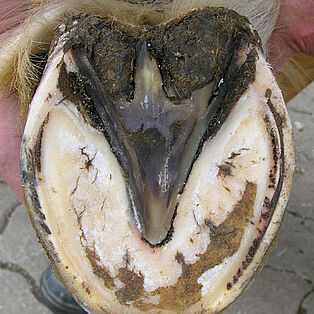

After the 8th treatment day on July 19th, 2012
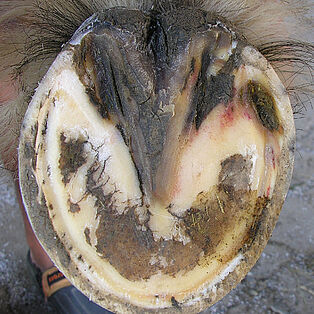
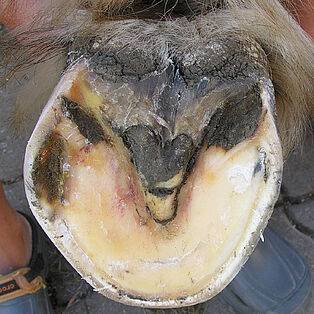


After the 9th treatment day on August 9th, 2012





What about all the other horses?
Nicki's story has taken a good turn, but what about the other horses in the mare's milk operation? As my colleague noted, at least one other mare whose hooves are affected by canker lives there. The mare is with foal and therefore cannot be put to sleep, nor will it be accepted by a butcher for slaughter. The horse also has pulmonary emphysema, so it is difficult to find someone who can provide for this horse properly. Another report to the Austrian authorities would not help this pregnant mare. The only solution for this horse might be the uptake by an animal welfare organization.

Even if the boarding conditions have improved somewhat due to the authority requirements, yet the operator’s attitude has still remained the same, the situation for animals is still unworthy. If you want to buy mare's milk, please consider whether you really need it. If so, buy only from farms where the animals producing the mare's milk are properly kept appropriate to the species horse, because then the market will adjust the end of the existing Misery.
